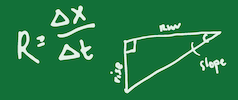Guiding Students through Vectors
An Instructor's Guide to: How Do I Use vectors?
Sarah Kruse, University of South Florida
John Zayac, Vassar College
What Should Students Get out of This Module?
After completing this module, a student should be able to:
- Recognize whether a quantity is a scalar or vector
- Identify trends and interpret Earth science processes from a map of vectors
- Find the components of vectors in 2D space
- Perform calculations that involve both scalar and vector quantities, both graphically and algebraically, and assess whether the solution is reasonable
Why Are These Math Skills Challenging to Incorporate into Courses?
Most two-dimensional vector exercises require a background in trigonometry. Even if your course does have a trigonometry prerequisite, students may not have facility with these skills and concepts. A separate trigonometry module or other background materials may be helpful or necessary for students with weaker or no trigonometry background.
Many problems that involve vectors include extra calculations or potentially unfamiliar quantities—for example: velocities, forces, stresses, etc. This can trip up students when setting up their work and interpreting the results of their calculations.
What Don't We Include on the Page?
This module is designed to allow students to learn, review, and practice vector basics in two-dimensional Cartesian space. All examples and quiz questions are one- or two-dimensional, but the principles in this module can be readily extrapolated to the many three-dimensional vector problems in the Earth sciences. Instructors are welcome to build upon the materials developed here, including adding polar coordinates and three-dimensional applications.
This module does not introduce the concepts of vector multiplication (dot products and cross products) and other types of vector manipulation from linear algebra.
Three-point problems commonly include vectors, but this module does not include any examples.
Using Vectors to Reinforce Student Learning in the Earth Sciences
Some instructors may find it useful to include practice for their students that asks them to interpret Earth science processes in a vector map.
For example, for the first problem on the landing page, we had originally drafted the following text to attempt to guide the students:
The yellow lines show plate boundaries. The image below zooms in on the velocities in the western United States. (a) Can you explain why the Cocos Island velocity is so different from velocities in Central America just to the north? (b) Is the plate boundary in California a sharp line between two rigid plates moving past each other, or a broader zone of shearing, like stretching a rubber sheet? Explain your answers.
- (a) The Cocos Island GPS station is on a different plate (the Cocos plate) than the stations to the north in Central America that are on the Caribbean plate, so those two plates clearly have very different motions. The Cocos plate is moving much faster and in a more northerly direction.
- (b) The velocities across California are generally northwestward, but they vary gradually from faster rates on the west to slower rates on the east. This gradual difference is what you would expect if stretching a rubber sheet in which the western side is moving faster than the eastern side, with intermediate rates in between. So this is not a sharp plate boundary.
Upon reflection, this text was moved here for your reference since the question asks for deeper content knowledge than we could include in this module.
Instructor Resources
Support for teaching this quantitative skill
- A review of trigonometric functions can be found in a complementary module: Trigonometry in the Geosciences.
- We recommend working problems graphically with pencil and paper in the classroom or using PhET online AND using algebra on vector components.
Examples of activities that use this quantitative skill
- This 1–2 hour class activity on vectors and slope stability from Teaching Quantitative Skills in the Geosciences builds out from the landslide worked problem in this module and does not require outside resources.
- This exercise for structural geology classes from GETSI uses GPS data and vector components to look at strain in active tectonic settings. It is part of a larger module designed for several weeks of class time, but comprehensive background material accompanies the exercise.
- This demonstration on GPS designed for introductory classes from Geodesy topical resources on Teach the Earth develops the idea of relative plate motions.
